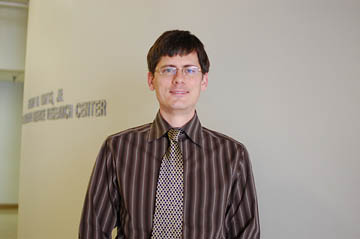Toby A. Ferguson, M.D., Ph.D.

Email:
toby.ferguson@uphs.upenn.edu
Telephone:
215-898-0181 (lab)
215-898-0180 (clinical)
Fax:
215-573-4454
Biographical Sketch
My initial exposure to research occurred as an undergraduate at the University of Florida. I studied tissue differentiation and spore coat-formation in dictyostelium discoideum with Dr. Christopher West, graduating with degree in cell biology and a minor in Asian studies. After my undergraduate studies, I entered the MD/PhD program at the University of Florida. My doctoral advisor was David Muir, PhD. In Dr. Muir’s lab I studied the role of metalloproteinases in nerve regeneration. Most importantly, my project led to a lifelong interest in the cell biology of peripheral nerve. To me the unique partnership between axon and Schwann cell provides an accessible window with which to study the interaction between glia and axons. I moved from Florida to the University of Pennsylvania to pursue a residency in neurology. After residency, I obtained further training in clinical neuromuscular disease, which most closely fit my interest in peripheral nerve cell biology. To further pursue my interests in the cell biology of peripheral nerve I joined Dr. Steve Scherer’s laboratory at the University of Pennsylvania.
Current Projects
I am broadly interested in recovery of function after peripheral nerve injury. One hundred years of study has established that two forms of plasticity are primarily responsible for this recovery. One: axons readily regenerate within the peripheral nerves of mammals, and two: skeletal muscle cells are efficiently reinnervated by terminal sprouting of uninjured motor axons (Cajal, 1928; Tello, 1907). These are the best-documented examples of adaptive plasticity in the nervous system. Although Schwann cells have been shown to play essential roles in both regeneration and sprouting, little is known about the molecules involved. This surprising situation owes at least in part to the finding that denervated Schwann cells express many trophic factors and cell adhesion molecules (CAMs), making it difficult to define the role of any one in promoting axonal regeneration or sprouting. NCAD is a homophilic CAM that is expressed on apposing cell membranes of both axons and Schwann cells. There is also considerable evidence that it can mediate neurite outgrowth in vitro. Therefore, NCAD is a strong candidate to mediate axon growth on Schwann cells during regeneration and sprouting and I have focused my initial efforts on this hypotheis. To analyze this problem, I am using Ncad “floxed” mice to determine whether neuronal cadherin (NCAD) mediates axonal regeneration or terminal sprouting by genetically deleting NCAD in Schwann cells and/or axons. In this project I use a combination of in vitro neurite outgrowth assays and in vivo models of nerve regeneration (sciatic nerve crush) or motor axon sprouting (partial denervation).
Cajal, R.Y. 1928. Degeneration and Regeneration of the Nervous System. Oxford University Press.
Tello, F. 1907. Degeneration et regeneration des plaques motrices.

